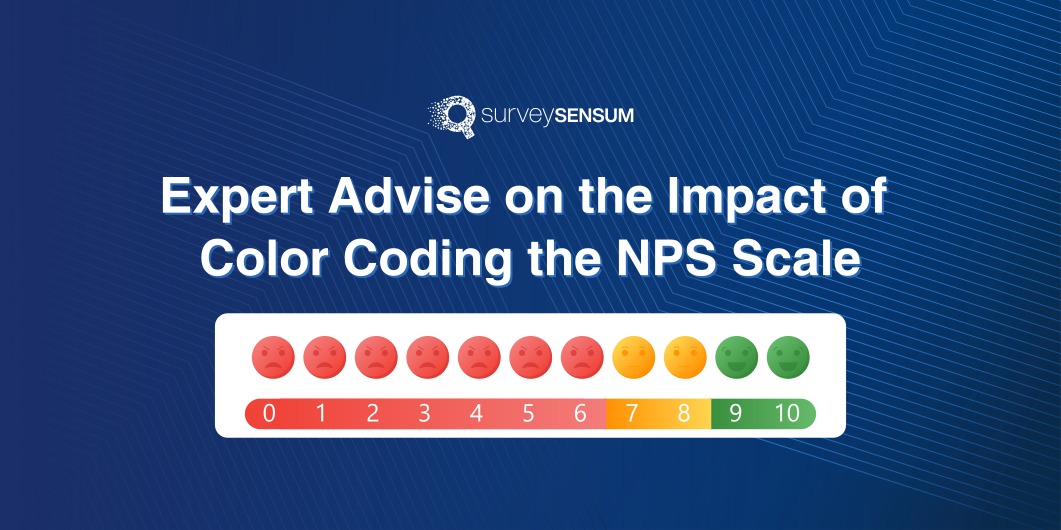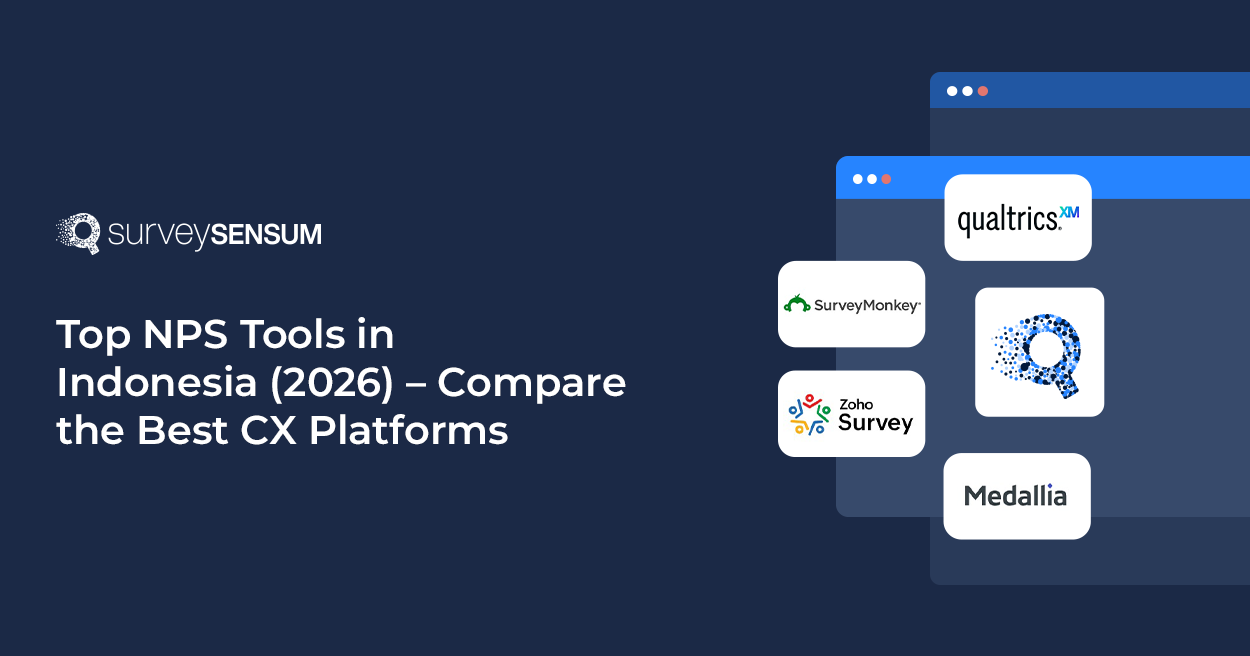

There has been a lot of discussion around the NPS surveys, but one question, however, remains unanswered –
Should you color code the NPS scale?
Mr. Tanuj Diwan, Head of Product at SurveySensum, took this discussion to LinkedIn, and many interesting and informative insights were shared by CX thought leaders.
And with many expert people sharing their thoughts, we collated everything here to give you a comprehensive picture of the controvertible topic of color coding the NPS Scale.

Why SHOULD you NOT color-code the NPS scale?
– It leads to biased customer feedback.
The NPS question in surveys is effective, but the response options being color-coded can influence respondents and result in distorted data. For instance, if a participant intended to choose a ‘6’ but sees the red color associated with it, they may alter their rating due to the impact of the colors.
Just as you drive when the traffic signal is green, similarly, customers are likely to click on the green color score, regardless of their actual experience. This results in biased responses, which is not suitable for a customer-focused organization.
By coloring the NPS scale, there is a significant chance of obtaining biased answers, which limits the ability to understand what customers genuinely feel, expect, and experience.
Rahul Sharma, Agile Coach and Customer Logistics at Delivery Hero, commented on the same – “The scale should not be color-coded because it can influence the customer to choose the color that might not reflect their honest feedback, instead go for conceptual recommendation on the full scale.”
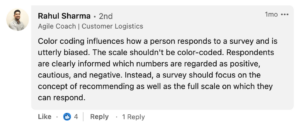
Michael Brandt, Founder, Senior Consultant & Trainer at CX-Excellence, strongly agrees with those who don’t support the red to green scale of NPS because it blatantly guides the respondent. And here, he shares his experience:
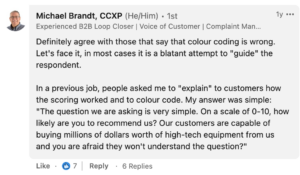
Sandip Gupta, Senior Manager of Customer Experience Transformation Specialist at HCL Tech, asserts the same opinion about not color coding the NPS scale. He believes that the core purpose of the survey should not be influenced by other factors.
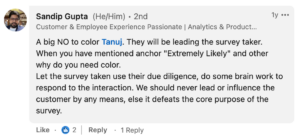
– Customers tend to shift their responses from yellow to green color.
Karthik Srivatsa, the CX consultant at Cisco, says that most of the responses are polarized in NPS surveys because respondents who’re happy or unhappy with the services will give a definite score. However, the passive respondents will get biased while responding because if they wanted to give an 8 yellow score, they might give a 9 because it’s green.
Having said that, he believes that coloring helps in reducing false positives or negatives. Moreover, in a country like India, it is best to make the survey as simple as possible and A/B test it before jumping to any conclusions.
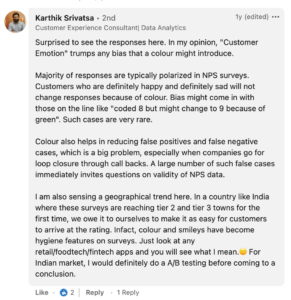
– Organizations sway from their objective of listening to the customers.
The reason we launch surveys is that we want to listen to the voice of the customers, and we need reliable, honest feedback for it. So, to make the best use of it, it’s best to use a neutral or colorless scale while gathering customer feedback.
– this will give you honest responses.
Sergio Rossini, Sales, Marketing & CX Director at Sagres, says that we should avoid guiding or influencing customer feedback and should ‘learn the art of listening’ to capture the customer feedback.
– It can be really challenging for color-blind respondents.
In the other comment Ryan Jones, Senior Director at Silverline, shares an example of red/green color blindness and how that respondent would never pick the yellow color because of that. That’s why closing the loop is important.

However, there are a few experts who believe that one should color code the NPS scale.
Launch Your First NPS Survey!
Why SHOULD you color code the NPS Scale?
– Educates the respondents on the ratings
Kentaro Abe, Vendor Operation Manager at ByteDance, talks about the usage of the NPS scale in Japan, specifically about how they don’t use 10 point scale and instead consider 5 as an acceptable score. Further, he emphasized the importance of identifying the key areas to improve NPS and working on those.
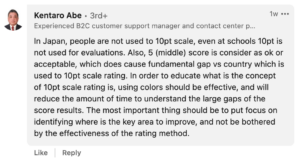
– Makes it easy for the respondents to respond
Julia Forsyth, Director and CEO of BigEars, says coloring the scale into red, yellow, and green makes the responder easily respond to the survey despite being illiterate or aged. Also, it requires less effort from customers to fill out the surveys.
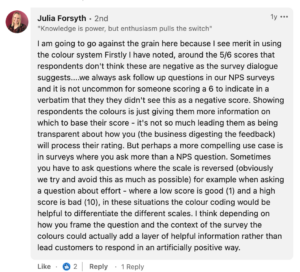
– Enhances inclusivity
Contradicting the popular belief, Doug Rabold, Senior Manager of Customer Support at Amwell, states that color coding and emoticons can enhance inclusivity because it makes it easy for disabled, illiterate, or dyslexic respondents to respond to the surveys. In CX, it is really crucial to gather feedback from all the customers.
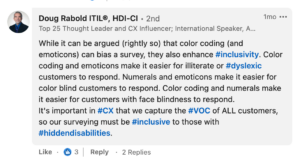
These were the significant pros and cons of coloring the NPS 11-point scale. It leads to biased feedback which is of new use and won’t help in improving the NPS score or enhancing the customer experience.
So, what is the solution?
Recommendations by the experts
Here are some great recommendations shared by experts on how to use the right NPS scale.
– Go for performance-based surveys, instead of NPS surveys
Instead of gauging the loyalty of the customers by asking NPS surveys, you must ask performance-based questions. So, keep the surveys as short as possible, like a yes or no, or maybe you can use a 5-point scale.
And here is what Debbie Akwara, Chief Executive Officer at Niche Customer Experience Group, has to say.
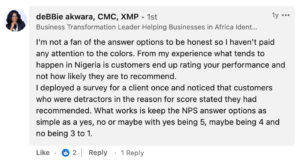
– Use 3 colorless emojis instead

Emoticons are universal.
So why not use them? – A short, easy, and straightforward scale to gather honest responses.
This scale will clearly tell you whether the customer is happy with your product or service or not.
Sreekiran KR, Senior Manager of Customer Success Operations at Trellix, comments if only 0 is colored as red and 10 is colored as green, and the rest of the scores are colored in progressive NPS colors then that could justify the 11-point scale else a 3-point scale is also sufficient to gather customer feedback. He further says that in Japan, an emoticon just at the bay of 10 and 0 indeed spiked the score and NPS response rate. And to get some valuable insights, conduct an A/B test.
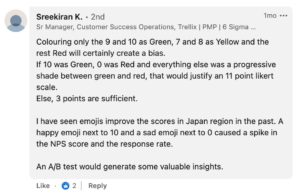
Also, Bethany Baker, a Program Manager at CHI Health, prefers to see emoticons with no NPS color coding because that helps deaf or illiterate patients.
“I’d like to see emojis used with no color coding. I believe this helps patients who may not speak or read the language well, and it’s universal. The numbered scale is always open for interpretation; emojis are clear – you’re happy, sad, angry, etc.”
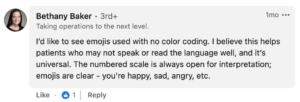
While so many opinions were shared (all of which were incredibly insightful), a few experts stated that it really doesn’t matter – if you color code the NPS Scale.
However, some say that coloring the NPS Scale has no influence
Simon Korsholm, Contact Centre Contract and Commercial Performance at South Central Ambulance Service NHS Foundation Trust, says that coloring the scale doesn’t really matter.
Because if you are labeling the ends right and they still are unsure about what to score, then those responses are not worth worrying about.
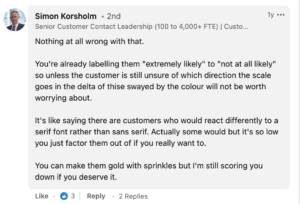
And the answer lies in the follow-up question
Thomas Johnston, Senior Vice President of Latam Operations and Global Quality Assurance at KM2 Solutions, shares some great insights on how and why follow-up questions are important.
One question cannot tell you the entire customer experience. You need to ask an open-ended question to know exactly what your customer feels about your products and services, their expectations, their likings and dislikes, and so on.
Asking an open-ended question after the NPS question will help you know where you’re lacking, what can be improved, and what you should continue to do.
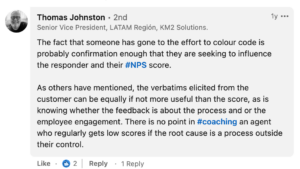
We believe..
We believe that a customer feedback survey is conducted to listen to the customer’s experience and expectations. So, we should not influence the scale or anything that misleads the calculation of the particular CX metric, be it NPS, CES, or CSAT.
To get honest responses, use a robust NPS software that will help you ask straightforward questions and choose the right scale with no color. Your focus should be on the key areas where you can improve to deliver the best customer experience and not just increase your NPS score.
Frequently Asked Questions
The CX industry is divided on this question. Some say that it enhances the quality of the survey and some say it distracts the customer and creates bias. It is often recommended to ask simple and straightforward questions in your surveys without creating distractions for customers.
The NPS scale ranges from -100 to +100. For example, an 11 point or a 5-point scale. Respondents rate their likelihood to recommend a product or service on a scale of 0 to 10. Promoters are those who rate 9 or 10, are loyal to your brand and can be turned into brand advocates, passives rate 7 or 8, and detractors rate 0 to 6. Calculate NPS by subtracting the percentage of detractors from the percentage of promoters.
NPS coding involves implementing the necessary software or programming to conduct NPS surveys, collect responses, calculate NPS scores, and analyze feedback.
There are two types of NPS surveys – rNPS and tNPS. While rNPS measures the overall relationship and loyalty between a customer and a company over time, tNPS focuses on specific transactions or interactions between the customer and the company. These surveys help in knowing customer satisfaction, loyalty and improving customer retention.
NPS software tools are platforms or solutions designed to facilitate NPS data collection, NPS analysis, and management of NPS data. These tools help businesses implement NPS surveys, track customer feedback, and measure NPS scores over time.
NPS benchmarking involves comparing your NPS with industry averages or competitors’ scores to gauge performance and identify areas for improvement. It provides context for understanding how your NPS stacks up against others in your industry or market segment, offering insights into your company’s relative standing in terms of customer loyalty and satisfaction.








